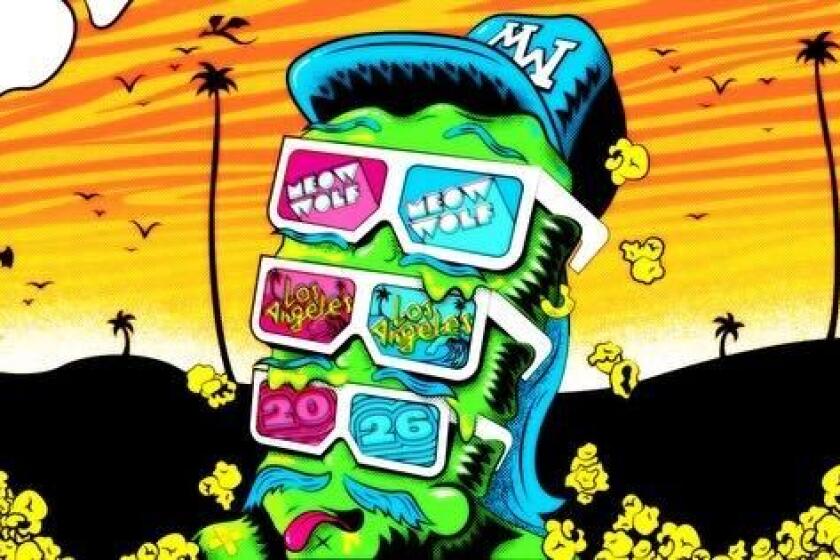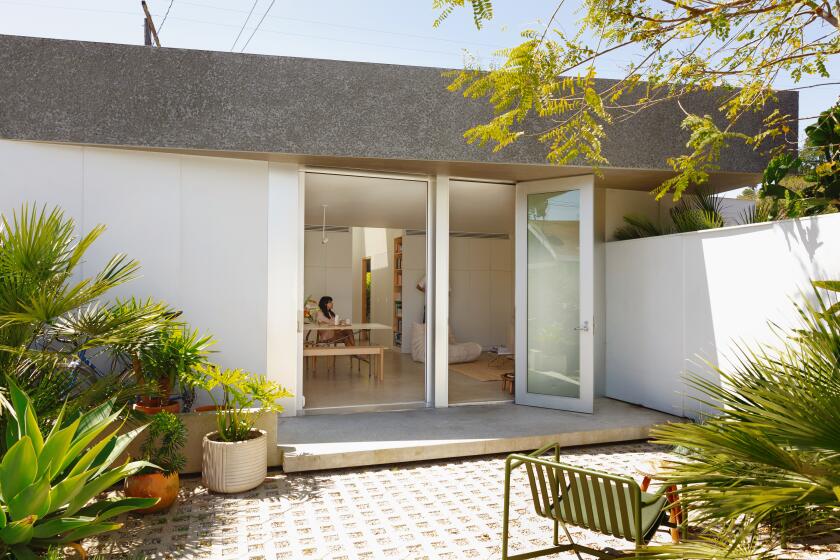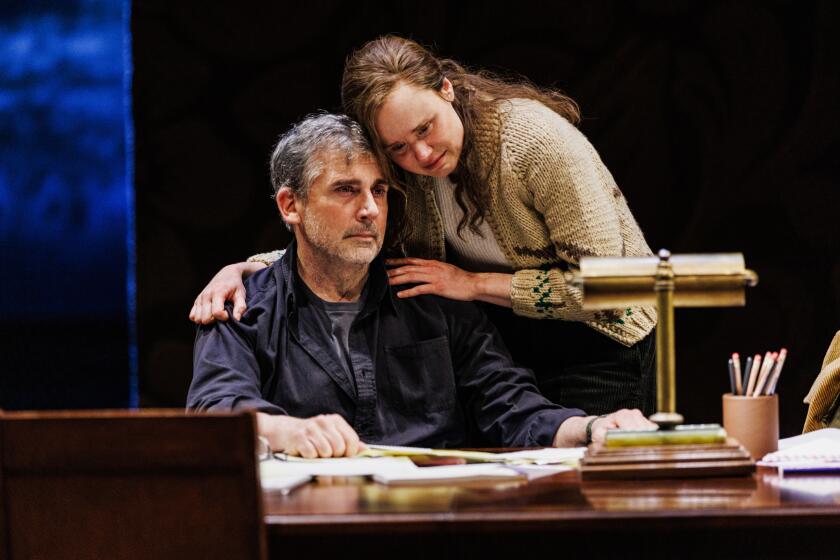Blending Actors and Objects : Belgian dancers push physical, psychic limits.
The couple sat so lightly on their chairs in a CalArts lounge area that it wouldn’t have been surprising if they had begun to levitate. They spoke lightly too: she hardly at all, he with a whisper-like tone that softened the edge on some difficult ideas he was trying to convey to his guest and a translator.
“May I speak in French?” asked Belgian-born Alain Mebirouk, co-founder of the experimental, Brussels-based performance group, Le Theatre de Banlieue. “I’m afraid of making a dangerous mistake!”
He carried on in his native tongue, describing the sometimes dangerous work that he and partner Isabelle Lamouline have developed into “La Nik a Wet,” their latest performance piece opening Saturday at the Odyssey Theatre.
What strikes one about these light-on-their-feet Belgians is hearing them explain a heavyweight theater discipline that sounds nearly masochistic. “La Nik a Wet” may have a running time of less than an hour, but the grueling and painful process of turning ideas into a performance consumed nine-hour rehearsal days spanning nearly five months.
Of course, Jerzy Grotowski, the Polish theater experimentalist par excellence whom 41-year-old Mebirouk studied with in the early ‘70s and cites as a key influence, would demand as many as 400 rehearsals before the first public performance. (The typical stage play has a three-to-four week rehearsal period.) But Mebirouk made it clear that his group is not in a catch-up race with their mentor; rather, their work simply requires tough preparation for a physical form of theater.
“We found ourselves working at such physical and psychic limits,” Mebirouk said of the “Nik a Wet” rehearsals, “that we couldn’t go on. Because of the depth and strain of work, it was too much” for the four other members of Banlieue, who will likely be in future productions.
“The virtuosity and endurance of these two actors is always impressive,” marveled San Francisco Bay Guardian critic Misha Berson about Banlieue’s “Aqui No Se Rinde” (a 1988 triumph at downtown’s Wallenboyd Theatre). “After a while you wonder what kind of super-cell batteries they’re running on.”
For all of Banlieue’s bodily precision and focus on the physical plane, critics also have an amusingly hard time trying to put a Banlieue show into words. After calling their 1986 “Eclaboussures” everything from “Beckett-like” to “dreamlike” with “demonic possessions” and “lascivious gargoyles,” Baltimore City Paper’s John Strausbaugh threw up his hands: “It was a strange pageant that can’t be explained and only described in flashes.” Of “No Place To Die,” the group’s first work in 1982, the San Francisco Chronicle’s Steven Winn wrote cryptically, “Like the best abstract painting,” the performance “means what it is, irreducibly.”
Actually, according to Mebirouk, that’s close to the mark. Their other major influences are Picasso, Paul Klee and the modern Italian sculptor Alberto Giacometti. After settling upon a general idea of the piece’s structure and themes, and the movement patterns within sequences, the Banlieue members become scavenging sculptors in the streets of Brussels.
“It’s a four-phase process,” explained Mebirouk. “We hop in our van and hunt for objects that please us, apart from any use they may have in a show. They could be old pipes or tubing or rubber. Then we bring them back to our studio and play with them. Third, we employ the objects with the performance ideas we’ve decided on. Fourth, we keep some objects and set a structure and rhythm for the piece.”
These objects becomes props, or extensions of the actors’ bodies--or even saxophones. In a 45-second sequence of “La Nik a Wet” that required two months of preparation, Lamouline’s Wet, a Skid Row woman, is grandly putting on makeup amid a trash heap while her companion Nik (Mebirouk) blows free jazz on an instrument made of pipes and funnels.
“We create sculptures for the performance,” said Mebirouk, “though we aren’t aware of that at the time. We try to see what we can use them for, and like any sculpture, a form emerges.”
Dance veteran Lamouline, 30, admitted that this way of working “demands a lot of perseverance. Performing with props is still new to me, but it’s fun. We forget how kids can invent toys from anything they find. We try to be childlike in that way.” Both are aware, though, that props can overwhelm performers. Mebirouk: “Always in our minds, the actor is just as important as the object.”
That is in keeping with Banlieue’s primary subject: the human being in a world filled with technology’s trash. It piles up so high, in fact, that people such as Nik and Wet can become part of the refuse. Despite--or, perhaps, because of--his three degrees in chemistry, mathematics and physics from the University of Brussels, Mebirouk looks askance on hi-tech sophistication. “Technological society hasn’t helped our humanity. I don’t think our performances, though, are any kind of revenge on the industrial world. Searching for links between world cultures, we’ve found that just because a society has more technology than another doesn’t make it stronger.”
Banlieue’s search has taken it to four continents, from Rome to Montreal, from Bogota to Cairo. Chicago and Los Angeles provide them with much support (the CalArts stay was for a weeklong workshop held with students there), but their most memorable experiences were far from the city lights. “We played in a Nicaraguan battle zone, a muddy field halfway between the Sandinistas and the Contras,” recalled Mebirouk. “It was so overwhelming that it took a few months for it to hit us.
“The most incredible incident was in Bogota. We did a free show in the plaza of a poor neighborhood. At first the audience was small. Then 400 people came down from the hills surrounding the plaza to join us. Kids started playing with our props. We performed for hours after ‘the show’ was over. It was magical, because theatricality and life blended completely.”
Like so many of the high priests of the avant-garde--Grotowski, Peter Brook--the Banlieue company is interested in grappling with non-Western cultures. “But it’s not a marriage of cultures that we’re after,” Mebirouk noted. “Oriental theater is metaphysical, not linear in narrative. Western theater is psychological, but often linear, not based on instinct. We want to bring a Westerner’s rigor to non-narrative theater.”
Yet while Banlieue may float between cultures, they do have a home. Shortly after their 1980 founding, they took over a former way station for Brussels’ municipal horse-and-buggy routes and turned it into a studio-performance space, plus a cafe and a bar. The space is rented out 10 months of the year, and that, with government support, funds the experimental globe-trotters.
“We’re going back there after being on the road six months,” Lamouline said, sounding relieved. “We’ll rest, but not as a group,” added Mebirouk. “We’re a collective, but not a communal group like the old Living Theatre. Sometimes, we want to be alone.”
“La Nik a Wet” plays at 10:30 p.m. Saturdays, 8 p.m. Feb. 15 and 16, 10:30 p.m. Feb. 17 and 3 p.m. Feb. 18 at Odyssey Theatre, 2055 Sepulveda Blvd. (213) 477-2055 . Tickets: $12.
More to Read
The biggest entertainment stories
Get our big stories about Hollywood, film, television, music, arts, culture and more right in your inbox as soon as they publish.
You may occasionally receive promotional content from the Los Angeles Times.






